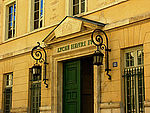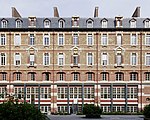Saint-Étienne-du-Mont
17th-century Roman Catholic church buildings in FranceRoman Catholic churches completed in 1624Roman Catholic churches in the 5th arrondissement of Paris

Saint-Étienne-du-Mont is a church in Paris, France, on the Montagne Sainte-Geneviève in the 5th arrondissement, near the Panthéon. It contains the shrine of St. Geneviève, the patron saint of Paris. The church also contains the tombs of Blaise Pascal and Jean Racine. Jean-Paul Marat is buried in the church's cemetery. The sculpted tympanum, The Stoning of Saint Stephen, is the work of French sculptor Gabriel-Jules Thomas. Renowned organist, composer, and improviser Maurice Duruflé held the post of Titular Organist at Saint-Étienne-du-Mont from 1929 until his death in 1986.
Excerpt from the Wikipedia article Saint-Étienne-du-Mont (License: CC BY-SA 3.0, Authors, Images).Saint-Étienne-du-Mont
Place de l'Abbé Basset, Paris 5th Arrondissement (Paris)
Geographical coordinates (GPS) Address Phone number Website External links Nearby Places Show on map
Geographical coordinates (GPS)
| Latitude | Longitude |
|---|---|
| N 48.8465 ° | E 2.348 ° |
Address
Église Saint-Étienne-du-Mont
Place de l'Abbé Basset
75005 Paris, 5th Arrondissement (Paris)
Ile-de-France, France
Open on Google Maps










